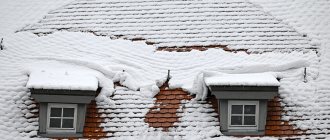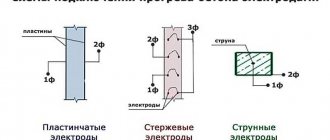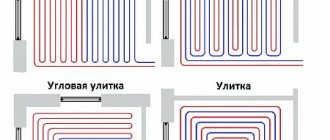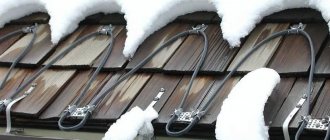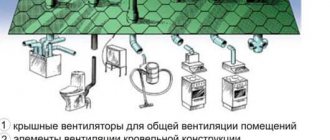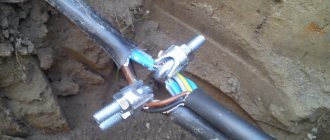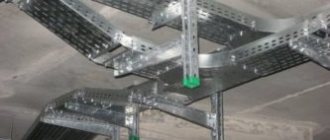One of the main problems in the operation of roofs in winter is the icing of the drainage system - pipes and gutters, as well as other roof elements.
Deforming and collapsing under the weight of snow and ice masses in the cold season, they confront maintenance services with the need for frequent repairs of gutters, damaged facades and overhead utilities. The optimal and, in fact, the only cure for the problems of winter operation of the roof and gutters is the “Teploskat” roofing element heating system, designed to ensure the drainage of melt water from the roof and prevent the formation of ice build-ups.
Purpose
The heating system for the roof and gutters is designed for installation on the roof elements of the building, in the drainage system (troughs, pipes), in places where snow may accumulate and ice and icicles form. Heating protects the roof from leaks, drains from deformation and breakage, and also ensures the safety of people and cars from possible falling icicles and snow/ice masses.
Expert advice
Some useful tips:
The cable can be laid both inside and outside the pipe. Typically, pipes with a diameter greater than 40 mm are tied with a self-regulating cable from the outside
If the pipe diameter is smaller, using an internal resistive one is suitable; It would be a good idea to ask the manufacturer for a hygiene certificate (especially important when heating pipes with drinking water); A new cable with food-grade braid may emit a pungent odor at the beginning of use - this is not scary; Before purchasing, check the level of energy consumption. If an open installation is planned, it is desirable to have UV/protection. For internal installation, a waterproof shell is required.
Task
The task of the anti-icing and heating system is to ensure unhindered removal of the resulting melt water from the roof surface through the drainage system until the water is completely removed from the roof and gutters. The anti-icing system of the roof eliminates the need for mechanical cleaning of snow and ice, which often leads to damage to the coating and gutters, and leaks.
How effective the roof heating will ultimately be depends on the professionalism of the designers and installers. When calculating and installing roof heating, it is necessary to take into account the design features of the roof, its slope, covering material, the presence of architectural elements that contribute to the accumulation and retention of masses of snow on the roof. Unqualified personnel and lack of experience in carrying out such work can lead to the fact that the cable heating system for gutters will not work effectively. Moreover, incorrect calculation of melt water flows or temperature loads from heating equipment through the roof (an example would be large heat release from production lines and machines in workshops or the installation of heating equipment in attics and attics) may not reduce the number of icicles, but rather increase it!
The main component of the system is heating cables. When placed in a drain, they provide a channel for melt water to drain and prevent clogging.
To heat the roof, two types of heating cables are used - resistive or constant power, and self-regulating.
A constant power heating cable has a constant, constant resistance along its entire length. The length of sections of these cables is fixed, therefore, when selecting the required section with a certain length, it is necessary to strictly follow the technical parameters.
Self-regulating heating cable provides the optimal solution for heating roofs and gutters in most cases. The peculiarity of this type is that they themselves change their heat release depending on environmental conditions and temperature. This prevents the cable from overheating and failing, which ensures high safety and reliability of the system. They are easily cut into sections of arbitrary length (up to several tens of meters) directly on site, which makes them convenient to use. The flat cross-section ensures good contact with the heated surface, reducing heat dissipation into the environment.
How to solve the icing problem
A special cable is used in the design of heating gutters. Its biggest drawback is that it does not work at temperatures below -15°C. But this is unimportant, since it is used during the thaw period. This happens for 3 reasons:
- At temperatures below -15°C, snow usually does not fall. Humidity is low.
- At sub-zero temperatures, excessive energy consumption occurs. When the temperature drops, the gutter heating cable begins to draw more electricity. And the lower, the more – for every 3°C, consumption increases by 1.5 times.
- In severe frosts, the heating cable melts the snow lying on the roof, which immediately turns back into ice. That is, the efficiency is practically zero. This means that turning on the heating system becomes pointless.
The problem of turning off the system is solved quite simply. A temperature sensor is inserted into its design, which is programmed for a maximum sub-zero temperature of -15°C. It turns off the power to the gutter heating when the outside temperature drops below the programmed value.
Methods for dealing with ice
There are several ways to deal with ice. Let's list the features and advantages of each of them: Mechanical. It involves removing sediment manually or using special equipment. A labor-intensive method that requires a lot of time and can lead to destruction of the surface being treated. Friction. This method does not remove ice, but increases the traction of wheels and shoes with the road surface. This is achieved through the use of materials (sand, crushed stone, ground gravel) with small particles with a diameter of 2-6 mm. Chemical. It is carried out using special preparations containing reagents and anti-corrosion additives. Separately, it is worth highlighting the thermal method, which involves heating with a power cable. The system consists of heating devices that melt the snow and prevent the surface from freezing. Advantages: efficiency, ease of connection, no need for constant monitoring.
How to choose a temperature sensor and how many of them are needed?
The choice of sensors is determined by the choice of the anti-icing system itself. Most of them have sensors included or their type is indicated in the documentation. Energy savings increase if not one, but at least two temperature sensors and two control and regulation zones are used. For example, for the southern and northern sides of the roof, where climatic conditions differ sharply. A high-quality thermostat is capable of monitoring the readings of four or more sensors, plus humidity sensors.
Pitched roofs
The main principle when determining the areas for laying the heating cable is to ensure the drainage of melt water from all elements of the roof, for which it is necessary to lay it in gutters, downpipes, valleys - places where ice is most likely to form. If the drainpipes are arranged in tiers, not of the same length, it is necessary to heat each section of the pipe and the section of melt water flow between adjacent pipes. The total length of the roof heating cable is determined by the total number of roof components that need to be heated.
If the roof slope is steep enough and there is a possibility of an avalanche of snow and ice, then it is necessary to install a snow retention system (Fig. 1). In this case, it makes sense to lay the wire like a snake between the edge of the roof and the snow guard. The height of the snake depends on the location of the snow retention elements or roofing material, but is usually 0.35-1.0 m.
If there is no likelihood of an avalanche of snow or there are no pedestrian paths/parking areas/underlying canopies and roofs under the heated area, then you can limit yourself to heating gutters and drains. Depending on the diameter and length of the drainpipes, the width of the gutters, the power of the heating cable and its quantity per linear meter of the drainage system are selected.
In cases where there is no organized drainage system on a building, depending on the height of the building and the slope of the roof, specialists decide on a method for heating areas that are dangerous from the point of view of snow accumulation. With a small building height, depending on the type of roofing, to remove snow and icicles, you can heat the drip edge or the edge of the roof like a “snake”. On high-rise administrative buildings or residential buildings, in the absence of a drainage system, heating the edge of the roof or dripline can lead to melt water partially falling on the facade of the building and freezing on it. As the façade freezes, masses of ice along with the façade cladding fall onto the sidewalks and roadways. Of course, this is unsafe for pedestrians and cars. In such cases, experts recommend first installing an organized drainage system that drains melt water from all areas of the roof to the ground, and then heating it with an electric cable.
Principles of laying cables for heating drainpipes
The installation of roof electric heating is simple and does not take much time. Installation rules depend on the type of heating.
Endovy.
The cables are placed at least 2/3 of the length of the valleys in two threads. In places where the roof adjoins vertical walls, the wires are also laid in two threads.
Cornice.
The wiring is mounted along it in 2-3 threads if the width of the structure is less than 300 mm. When heating roof eaves, the calculation is 250–300 W/m². The wire is installed in the form of a snake. The laying step for soft roofs is 35–40 cm; on hard ones it should be a multiple of the pattern.
Drainage gutter.
At least two threads of wire are placed on it. The total rated heating power of the gutter per linear meter is 50 W or more.
Dropper.
Lay 1 or 2 threads of cable - this depends on the design of the drip line.
Drainage trays.
Calculation of heating of gutters depends on the size of the trays. At a rated power of 50 W/m with a tray width of 50–100 mm, two threads of cable are required, from 60 W/m with a tray width of 100–150 mm - at least two threads, from 75 W/m with a tray width of more than 150 mm - at least three threads.
Drainpipes with funnels.
The rated power depends on the pipe diameter. If it is up to 120 mm, it should be equal to 25–30 W/m, one thread of cable is required. To heat funnels with a diameter of more than 120 mm, two strands of wire with a power of 50–60 W/m are used.
Flat roofs
On flat roofs, as a rule, drainpipes run inside the building (Fig. 1). It is not necessary to heat them over their entire length in cases where the pipes pass through the body of a warm building. The heating cable is laid out over an area of 1 sq.m around the water intake funnel like a “snake” and inserted into the funnel to a depth of about 1 m to the warm zone.
If the flat roof of a building is fenced around the perimeter with a parapet, the organized drainage system consists of trays inserted into the openings of the parapets (water jets) and external drainpipes. In this case, an area of 1 sq. m is heated. m in front of the water cannon, the tray itself or the bottom of the water cannon and the entire length of the drain pipe. In the absence of drainpipes, there is a danger that melt water, dripping from a water cannon, will partially freeze on the facade of the building and, as the mass accumulates, this frozen moisture with pieces of the facade cladding may fall onto the sidewalks. That is why, when calculating a heating system, as in the case with pitched roofs, experts recommend first installing a drainage system and then heating it with an electric cable.
What does the anti-icing system consist of?
To install the anti-ice system we will need the following elements:
- the heating cable itself;
- control panel;
Panel for control equipment. (photo No. 8)
- three-wire power cable (VVG);
- temperature, snow, water sensors - installed on the roof, in gutters and drainpipes to collect data and automate the system;
- cable KVVG for connecting sensors;
- controller or thermostat (minimum temperature range from −8 to +3 degrees; the larger this range, the easier it is to automate the operation of the system);
- protective distribution boxes with degree of protection IP55;
- mounting tape to secure the heating cable;
Mounting tape and method of fixing the cable in it. (photo No. 9)
- galvanized chain or cable;
- sealant;
- modular input circuit breaker with residual current device; as an alternative - a difavtomat with a similar current;
- modular starter;
- three-position switch that allows you to switch between automatic and manual modes;
- thermostat;
- temperature, water and snow sensors;
- circuit breakers.
Application on objects
Cable roof heating systems with high heat transfer are used:
In civil engineering:
- Residential buildings and office and business centers;
- Entertainment centers and sports and recreation complexes;
- Low-rise construction, cottages;
- Hotels and indoor sports facilities;
- Stations;
- Objects of cultural heritage: theaters, museums, libraries, houses of culture;
- Schools, kindergartens, hospitals;
- Glass-transparent structures of shopping malls, atriums, lanterns and winter gardens.
In industry:
- Factory and workshop buildings;
- Warehouses;
- Administrative buildings;
- In the shipbuilding industry when heating elements of civil ships;
- In aviation, in heating the roofs of airports and infrastructure facilities (hotels, terminals, hangars);
- In the railway sector for heating railway stations and switches.
Anti-icing systems produced are universal - they can be used for any structures and types of roofs, including soft and inverse, as well as translucent structures. They can be installed on ready-made objects. The service life of the roof heating system is at least 10 years.
Taking into account the fact that the average operating time of a roof heating system per season is about 1.5 months, the cost of installing the system pays off in less than 3 years, compared to the annual costs of mechanical snow removal and preventive repairs of the roof covering.
